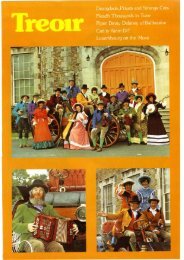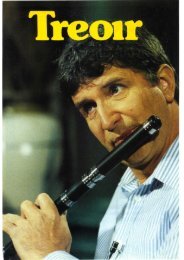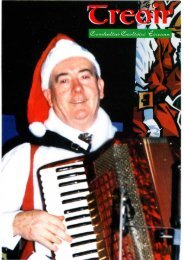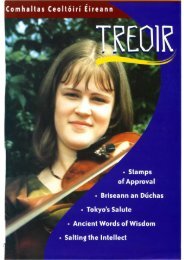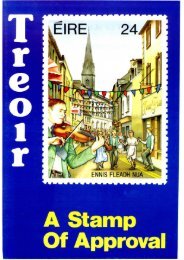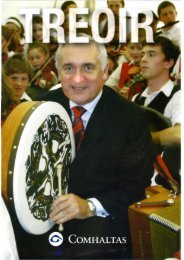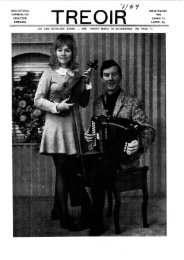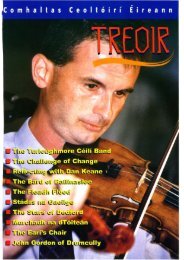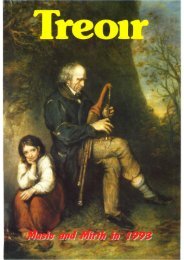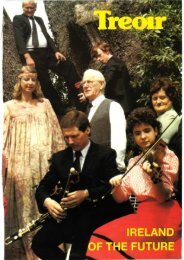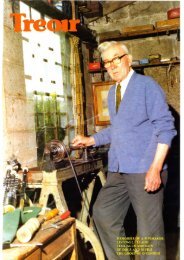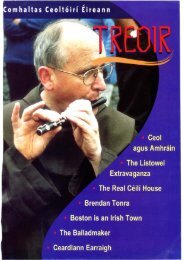Create successful ePaper yourself
Turn your PDF publications into a flip-book with our unique Google optimized e-Paper software.
letters is totally different to that of the<br />
Latin or any other alphabet. The letters<br />
were formed by combinations of short<br />
lines on and at both sides of a middle<br />
or stem line called a 'flesc'. Points or dots<br />
were sometimes used instead of lines. The<br />
groups of lines and points generally ran<br />
along the adjacent sides of the stone,<br />
with the angle for the flesc.<br />
Irish poetry was widely recited long<br />
before writing became generally practised<br />
and it was developed altogether in the lay<br />
schools. It had a very complicated<br />
prosody - certain laws or rules - with<br />
numerous technical terms, all native Irish;<br />
It exhibits no trace of Latin or<br />
ecclesiastical influence, though the<br />
Christian Irish writers continued to use it<br />
when writing in the Irish language . All<br />
this shows that the Irish prosodial rules<br />
and of course Irish poetry in general were<br />
brought to their state of completeness<br />
before the introduction of Christianity.<br />
In very early times, not only poetry<br />
proper, but histories, biographies, laws,<br />
genealogies and such like were often<br />
written in verse as an aid to the memory.<br />
The prosodial rules which the poets had<br />
to observe in the construction of their<br />
verse had as it's main object harmony of<br />
numbers. The classification and the laws<br />
of Irish versification were probably the<br />
most complicated that were ever<br />
invented ; indicating that the Irish people<br />
had a delicate appreciation of harmonious<br />
combinations of sounds. The "dan<br />
direach" or 'direct metre', most generally<br />
used verse structure, required the strict<br />
observance of such rules as , :- (1) each<br />
stanza to consist of four lines making<br />
complete sense; (2) each line to be of<br />
seven syllables; (3) alliteration in at least<br />
two principal words of each line ; (4)<br />
the lines to rhyme , the rhymes being<br />
greatly varied and occurring very often;<br />
(5) the last word of the second line to<br />
have one syllable more than the last word<br />
of the first line and a like relation<br />
between the last words of the fourth and<br />
third lines.<br />
The rhymes were very frequent in all<br />
stypes of Irish poetry, occurring, not only<br />
at the ends of the lines, but also within<br />
them, once, twice, or even three times.<br />
The rhymes were either between vowels<br />
i.e. assonances ,or between<br />
consonants. For this latter purpose the<br />
consonnants were scientifically divided<br />
into six classes ; 'soft', 'hard', 'rought',<br />
'strong', 'light' and the 'queen: - i.e.<br />
the letter "s" - which formed the sixth<br />
class; the letters of each of the first five<br />
corresponding and rhyming with each<br />
other, but not with those of any other<br />
class. One syllable, two syllable and<br />
three syllable rhymes were used with<br />
equal facility.<br />
After the introduction of Christianity,<br />
those of the Irish poets - whether clerical<br />
or lay - who learned to write Latin,<br />
imported many of the Irish prosodial<br />
rules into their Latin poetry, using accent<br />
instead of quantity, so as to imitate<br />
exactly the metres, assonantal rhymes,<br />
alli terations, consonantan harmonies and<br />
all the other ornaments common in Irish<br />
poetry.<br />
The schools and colleges of ancient<br />
Ireland were of two classes, Ecclesiastical<br />
and Lay. The ecclesiastical or monastic<br />
schools were introduced with Christianity<br />
and conducted by monks, the Second<br />
Order of Irish saints. The First Order<br />
were all Bishops, beginning with St.<br />
Patrick himself, missionaries and all<br />
founders of churches. The Third Order<br />
were hermits, mostly priests, who lived in<br />
desert places, refusing to possess private<br />
property, subsisting on herbs and water<br />
and on the alms of the faithful. In the<br />
monastic institutions the Abbot had<br />
charge of both the monastery and school<br />
or college. He deputed his authority in<br />
special directions and it became the<br />
custom to appoint a head professor to<br />
preside over, and be responsble to the<br />
Abbot for the educational functions<br />
of the college. He was called "Fear<br />
Leighinn" , or Chief Lector.<br />
The School of Armagh appears to have<br />
been the oldest of the ancient<br />
schools of Ireland, dating back to the<br />
foundation of the See of Armagh by St.<br />
Patrick. From it's foundation onwards,<br />
'the growth of the monastic schools really<br />
flourished with the cenobite, or second<br />
order of saints, influence of the late<br />
fifth and early sixth centures. The most<br />
notable of these earlier institutions were<br />
Aran founded by Saint Enda, Clonard by<br />
Saint Finian and Clonrnacnoise by Saint<br />
Ciaran. In a short time the Irish monastic<br />
schools were celebrated all over Europe.<br />
Luxeuil, in France, founded by Saint<br />
Columban, late sixth century, was one of<br />
the great early Irish monastic foundations<br />
' on the continent, and from which many<br />
others were later established.<br />
When this great monastic movement<br />
began there was a rapid growth of schools<br />
and colleges all over the country. Almost<br />
every large monastery had a school<br />
attached and it often happened that a<br />
school rose up around some scholar of<br />
exceptional eminence where it was not<br />
intended. Secular as well as ecclesiastical<br />
learning was carefully attended to in<br />
these schools, for besides divinity, the<br />
study of the Scriptures and classics, for<br />
those intended for the church, the<br />
students were instructed in general<br />
literature and science. Accordingly, a<br />
large proportion of the sons of kings and<br />
chiefs - intended, not for the church,<br />
but for ordinary civil or military life, who<br />
attended to get a goodgeneral education.<br />
The lay or secular schools existed<br />
from a period of unknown antiquity and<br />
in pagan times were taught by the druids.<br />
These men, white robed with cut tonsure,<br />
were a numerous and important class and<br />
the sole possessors of whatever learning<br />
was then known. They combined in<br />
themselves all the learned professions.<br />
They were not only druids, but judges,<br />
prophets, historians, poets and even<br />
physicians. The ancient Irish had<br />
druidesses also and references to their<br />
existence are made in several of the old<br />
writings.<br />
The druids had the reputation of being<br />
great magicians and in this character they<br />
figure more frequently and conspicuously<br />
than in any other, both in ecclesiastical<br />
and lay literature. They were the intermediaries<br />
of the fairies and with the<br />
invisible world in general, which they<br />
could influence for good or evil. They<br />
were employed by kings and chiefs to<br />
educate their children and the chief druid<br />
was the king's confidential adviser on<br />
important affairs.<br />
The conversion of Ireland to<br />
Christianity and the ending ' of pagan<br />
druidism marked the beginning of a new<br />
era in learning and education. The<br />
facilities available for secular learning in<br />
the monastic schools influenced and<br />
encouraged the establishment of many<br />
lay schools. Nearly all the professional<br />
physicians, poets, lawyers, builders and<br />
historians were laymen, as were many of<br />
those distinguished in art and general<br />
literature. Lay tutors were often<br />
employed to teach princes and, in fact,<br />
laymen played a very important part in<br />
the diffusion of knowledge and in<br />
building up that character for learning<br />
that rendered Ireland so famous in former<br />
times.<br />
The Bardic schools were the least'<br />
technical of the lay schools anti young<br />
men not intended for professions<br />
attended them. Subjects of poetry, hi<br />
history, general literature and law were<br />
taught in them. Most of these lay schools<br />
3



